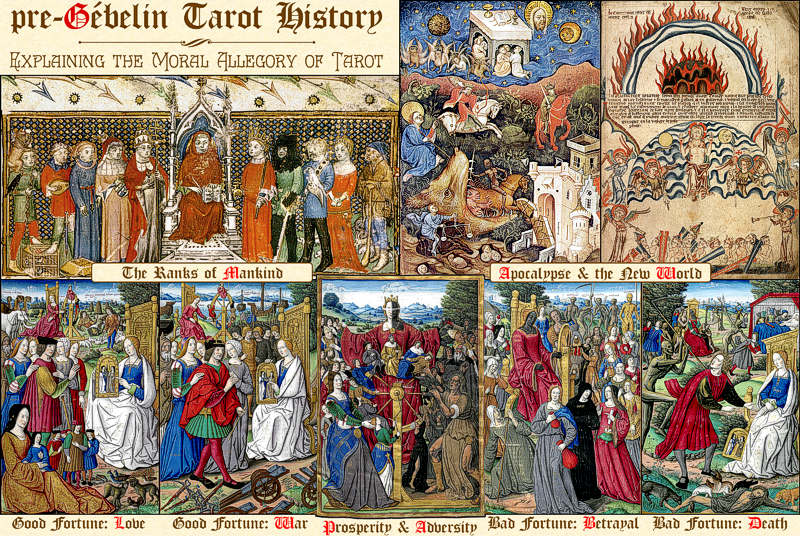My next post in the trees series is still in preparation. (I know... it's been a couple months now.) In the meantime, here is a nice diversion. The British Library has a tattered old 16th-century print (Huth.50.(32)) titled The Daunce and Song of Death. It is a wonderful variant on the perennial theme, with a balanced yet lively composition.


"Sycknes, Deathes minstrel" is at the center of the composition, playing a horn and drum while sitting on a chair of bones, balanced on a pick and shovel placed across an open grave. The doomed figures, dancing with Death, are arrayed in five contrasting pairs. Three groups dance in a circle around the grave. At the head of the procession (top-center of the sheet) a dancing skeleton leads a "Kyng" and "Begger". Behind them, another dancing skeleton leads an "Old Man" and a "Childe". Bringing up the rear of the procession, bottom-center, a third dancing skeleton leades a "Wyse Man" and a "Foole". In each case the opposites imply universality via merism. The associated verse makes this clear:
Come, daunce this trace, ye people all,
Both Prince and Begger, I say;
Yea, old, yong, wyse, and fooles I call,
To graue, come, take your way.
For Sicknes pipes thereto,
By griefes and panges of wo.
Two more contrasting pairs are present in the corners. The upper-left shows a miser, while the lower-right shows lovers with food and drink. Greed and Lust, each vignette has a skeletal Death figure and a verse.
From your gold and siluer
To graue ye must daunce;
Though you loue it so deare,
And haue therein affiaunce.
Ye dallying fyne Louers,
In mydst of your chere,
To daunce here be partners,
And to graue draw ye nere.
The upper-right corner shows a judge passing judgment, while the lower-left shows a prisoner chained in his cell. The just and unjust are both condemned.
From trone of iust iudgement,
Syr Judge, daunce with vs;
To graue come incontinent
From state so glorious.
Thy pryson and chaynes
From graue cannot keepe;
But daunce, though in paynes,
Thou shalt thereto creepe.

The overall composition, a circular dance with additional figures outside that grouping, is reminiscent of the later, more formal and much more complex Polish/German Dance of Death tradition. Paintings and prints in that tradition were made in the 17th and the 18th centuries. Whether there is a direct influence from the 16th-century English model is an interesting question. Certainly none of the details of the later design seem necessarily derivative from the earlier.



- Polish Painting, 17th century
- Polish Painting, 17th century
- German Broadside, 17th century
- German Broadside, 17th century
- German Broadside, c.1700
- German Painting, 18th century
- German Broadside, mid 18th century

The Daunce and Song of Death print may be the same as the one mentioned in records of The Stationers' Company. John Awdelay is noted as printing “the Daunce and songe of Deathe” for 1568-9. Alternatively, that may refer to a ballad with a very similar name. There were a number of such ballads printed on broadsheets, such as “The dolefull Dance and Song of Death”, “The roll of the Daunce of Death”, “The Dance and Song of Death”, and “The Dance of Death”.
On a related note, there are a number of other macabre broadside ballads, and many are available online. Broadside ballads “are almost as old as print technology, as they were probably already in circulation at the end of the fifteenth century”, and many have an illustration or two as well as the text. Of course, many more broadsides were not songs but tracts on various topics. Some of these are also related to the moral subject matter of Tarot’s trump cycle. Here are a couple notes on broadsides, a couple collections of broadside ballads, and a couple other examples.
- Broadside Ballads and the Oral Tradition
- Short History of Broadside Ballads
- Broadside Ballads Online
- English Broadside Ballads Archive
- Time's Precious Jewel
- The Vanity of Human Life
One popular broadside ballad is Death and the Lady, and many examples of it are online. Different versions have different layouts and different illustrations, but the song is essentially the same. It is, in effect, an elaboration of a single scene from the Dance of Death. From the late Middle Ages through the 18th and 19th centuries, macabre meditations on death were a commonplace subject for pop culture. The Tarot trump cycle is one such manifestation, perfectly appropriate moral subject matter for a perfectly respectable game.









